GIS-Based Landslide Susceptibility Mapping with a Blended Ensemble Model and Key Influencing Factors in Sentani, Papua, Indonesia
Abstract
1. Introduction

2. Materials and Methods
2.1. Study Area
2.2. Input Data
2.2.1. Landslide Inventory Map
2.2.2. Landslide Factors
2.2.3. Dataset and Sampling
2.3. Method
2.3.1. Data Input
2.3.2. Preprocessing
2.3.3. Modeling
- Random Forest (RF)—a bagging-based ensemble of decision trees that reduces overfitting and effectively handles noisy, high-dimensional data. It is valued for its robustness and generalization ability across heterogeneous environmental datasets [57].
- XGBoost (Extreme Gradient Boosting)—a boosting algorithm designed for computational efficiency and accuracy, capable of modeling complex non-linear relationships. It incorporates regularization terms to further reduce overfitting [17].
- CatBoost—a gradient boosting method optimized for categorical and imbalanced data. By employing ordered boosting, it minimizes bias and variance, performing well with relatively small to medium-sized datasets, common in geohazard studies [18].
2.3.4. Validation and Interpretability
- AUC (Area Under the ROC Curve):
- Accuracy:
- Precision (Positive Predictive Value):
- Recall (Sensitivity or True Positive Rate):
- F1-score:
- AUC assesses overall discriminatory power;
- Accuracy reflects general correctness;
- Precision emphasizes reliability of positive predictions;
- Recall stresses completeness in capturing landslides;
- F1-score balances the trade-off.
- 1.
- Model-specific Feature Importance (RF, XGBoost, CatBoost):
- 2.
- SHAP (SHapley Additive Explanations):
2.3.5. Output: Spatial Prediction and Zonation
3. Results
3.1. Preprocessing Results
3.2. Modeling Results
3.3. Validation and Interpretability Results
4. Discussion and Recommendations
5. Conclusions
Author Contributions
Funding
Data Availability Statement
Acknowledgments
Conflicts of Interest
References
- Jomelli, V.; Pavlova, I.; Giacona, F.; Zgheib, T.; Eckert, N. Respective Influence of Geomorphologic and Climate Conditions on Debris-Flow Occurrence in the Northern French Alps. Landslides 2019, 16, 1871–1883. [Google Scholar] [CrossRef]
- Ballesteros-Cánovas, J.; Kariya, Y.; Imaizumi, F.; Manchado, A.; Nishii, R.; Matsuoka, N.; Stoffel, M. Debris-Flow Activity in the Japanese Alps Is Controlled by Extreme Precipitation and ENSO—Evidence from Multi-Centennial Tree-Ring Records. Glob. Planet. Change 2023, 231, 104296. [Google Scholar] [CrossRef]
- Guzzetti, F.; Peruccacci, S.; Rossi, M.; Stark, C.P. The Rainfall Intensity–Duration Control of Shallow Landslides and Debris Flows: An Update. Landslides 2008, 5, 3–17. [Google Scholar] [CrossRef]
- Baum, R.L.; Godt, J.W. Early Warning of Rainfall-Induced Shallow Landslides and Debris Flows in the USA. Landslides 2010, 7, 259–272. [Google Scholar] [CrossRef]
- Jakob, M.; Hungr, O. Debris-Flow Hazards and Related Phenomena, 1st ed.; Springer: Berlin/Heidelberg, Germany, 2005. [Google Scholar]
- Ishizuka, T.; Kaji, A.; Morita, K.; Mori, T.; Chiba, M.; Kashiwabara, Y.; Yoshino, K.; Uchida, T.; Mizuyama, T. Analysis for a Landslide Dam Outburst Flood in Ambon Island, Indonesia. Int. J. Eros. Control Eng. 2017, 10, 32–38. [Google Scholar] [CrossRef]
- Larsen, M.C.; Wieczorek, G.F.; Eaton, L.S.; Morgan, B.A.; Torres-Sierra, H. Venezuelan Debris Flow and Flash Flood Disaster of 1999 Studied. Eos Trans. Am. Geophys. Union 2001, 82, 572–573. [Google Scholar] [CrossRef]
- Rodolfo, K.S.; Lagmay, A.M.F.; Eco, R.C.; Herrero, T.M.L.; Mendoza, J.E.; Minimo, L.G.; Santiago, J.T. The December 2012 Mayo River Debris Flow Triggered by Super Typhoon Bopha in Mindanao, Philippines: Lessons Learned and Questions Raised. Nat. Hazards Earth Syst. Sci. 2016, 16, 2683–2695. [Google Scholar] [CrossRef]
- Froude, M.J.; Petley, D.N. Global Fatal Landslide Occurrence from 2004 to 2016. Nat. Hazards Earth Syst. Sci. 2018, 18, 2161–2181. [Google Scholar] [CrossRef]
- Kompas Banjir Bandang Sentani, Tiga Tahun Berselang. Available online: https://www.kompas.id/artikel/banjir-bandang-sentani-tiga-tahun-berselang (accessed on 31 August 2025).
- Kristiawan, Y.; Budianto, A.; Santosa, I.; Suryadana, K.M. Untuk Tanggap Darurat Banjir Bandang Sentani, Debris Flow Modelling for Emergency Response on Debris. 2021. Available online: https://www.researchgate.net/publication/350310308 (accessed on 1 September 2025).
- Arango-carmona, M.I.; Voit, P.; Hürlimann, M.; Aristizábal, E.; Korup, O. Hillslope-Torrential Hazard Cascades in Tropical Mountains. EGUsphere 2025, 2025, 1–30. [Google Scholar] [CrossRef]
- Fell, R.; Corominas, J.; Bonnard, C.; Cascini, L.; Leroi, E.; Savage, W.Z. Guidelines for Landslide Susceptibility, Hazard and Risk Zoning for Land-Use Planning. Eng. Geol. 2008, 102, 99–111. [Google Scholar] [CrossRef]
- Cascini, L. Applicability of Landslide Susceptibility and Hazard Zoning at Different Scales. Eng. Geol. 2008, 102, 164–177. [Google Scholar] [CrossRef]
- Casagli, N.; Frodella, W.; Morelli, S.; Tofani, V.; Ciampalini, A.; Intrieri, E.; Raspini, F.; Rossi, G.; Tanteri, L.; Lu, P. Spaceborne, UAV and Ground-Based Remote Sensing Techniques for Landslide Mapping, Monitoring and Early Warning. Geoenvironmental Disasters 2017, 4, 9. [Google Scholar] [CrossRef]
- Breiman, L. Random Forests. Mach. Learn. 2001, 45, 5–32. [Google Scholar] [CrossRef]
- Chen, T.; Guestrin, C. XGBoost: A Scalable Tree Boosting System. In Proceedings of the 22nd ACM SIGKDD International Conference on Knowledge Discovery and Data Mining, San Francisco, CA, USA, 13–17 August 2018; pp. 785–794. [Google Scholar] [CrossRef]
- Prokhorenkova, L.; Gusev, G.; Vorobev, A.; Dorogush, A.V.; Gulin, A. Catboost: Unbiased Boosting with Categorical Features. Adv. Neural Inf. Process. Syst. 2018, 31, 6638–6648. [Google Scholar]
- Ganaie, M.A.; Hu, M.; Malik, A.K.; Tanveer, M.; Suganthan, P.N. Ensemble Deep Learning: A Review. Eng. Appl. Artif. Intell. 2022, 115, 105151. [Google Scholar] [CrossRef]
- Mienye, I.D.; Sun, Y. A Survey of Ensemble Learning: Concepts, Algorithms, Applications, and Prospects. IEEE Access 2022, 10, 99129–99149. [Google Scholar] [CrossRef]
- European Space Agency (ESA) Copernicus Browser. Copernicus Data Space Ecosystem. Available online: https://dataspace.copernicus.eu/ (accessed on 1 September 2025).
- VOA Indonesia BNPB: Banjir Bandang Sentani Akibat Ulah Manusia Yang Merusak Alam. Available online: https://www.voaindonesia.com/a/bnpb-banjir-bandang-sentani-akibat-ulah-manusia-yang-merusak-alam/4836093.html (accessed on 1 September 2025).
- BBC Indonesia Banjir Sentani, Papua: Curah Hujan Masih Tinggi, Waspadai Banjir Susulan. Available online: https://www.bbc.com/indonesia/indonesia-47600617 (accessed on 1 September 2025).
- Diamond, J.; Bishop, K.D. Why Are New Guinea’s Cyclops Mountains Poor in Upland Bird Species? Bull. Br. Ornithol. Club 2025, 145, 60–90. [Google Scholar] [CrossRef]
- BRIN Attenborough’s Long-Beaked Echidna Rediscovered in Papua. Available online: https://www.brin.go.id/en/news/116646/attenboroughs-long-beaked-echidna-rediscovered-in-papua (accessed on 2 September 2025).
- Suwarna, N.; Noya, Y. Geological Map of The Jayapura (Peg. Cyclops) Quadrangle, Irian Jaya Scale 1:250.000 1995. Available online: https://geologi.esdm.go.id/geomap/pages/preview/peta-geologi-lembar-gunung-doom-irian-jaya (accessed on 2 September 2025).
- IRIS Interactive Earthquake Browser—Global Earthquake Catalog. Available online: https://ds.iris.edu/ (accessed on 1 March 2025).
- BMKG Earthquake Event Catalog. Jakarta: BMKG. Available online: https://repogempa.bmkg.go.id/eventcatalog (accessed on 1 March 2025).
- BIG Ina-Geoportal Geospasial Untuk Negeri. Available online: https://tanahair.indonesia.go.id/portal-web/ (accessed on 1 May 2025).
- Hengl, T.; Mendes de Jesus, J.; Heuvelink, G.B.M.; Ruiperez Gonzalez, M.; Kilibarda, M.; Blagotić, A.; Shangguan, W.; Wright, M.N.; Geng, X.; Bauer-Marschallinger, B.; et al. SoilGrids250m: Global Gridded Soil Information Based on Machine Learning. PLoS ONE 2017, 12, e0169748. [Google Scholar] [CrossRef]
- Zanaga, D.; Van De Kerchove, R.; Daems, D.; De Keersmaecker, W.; Brockmann, C.; Kirches, G.; Wevers, J.; Cartus, O.; Santoro, M.; Fritz, S.; et al. ESA WorldCover 10 m 2021 V200 2022. 2022. Available online: https://research.wur.nl/en/datasets/esa-worldcover-10-m-2021-v200 (accessed on 1 September 2025). [CrossRef]
- Lee, S.; Talib, J.A. Probabilistic Landslide Susceptibility and Factor Effect Analysis. Environ. Geol. 2005, 47, 982–990. [Google Scholar] [CrossRef]
- Kamp, U.; Growley, B.J.; Khattak, G.A.; Owen, L.A. GIS-Based Landslide Susceptibility Mapping for the 2005 Kashmir Earthquake Region. Geomorphology 2008, 101, 631–642. [Google Scholar] [CrossRef]
- Price, K. Effects of Watershed Topography, Soils, Land Use, and Climate on Baseflow Hydrology in Humid Regions: A Review. Prog. Phys. Geogr. 2011, 35, 465–492. [Google Scholar] [CrossRef]
- Fusco, F.; De Vita, P.; Mirus, B.B.; Baum, R.L.; Allocca, V.; Tufano, R.; Di Clemente, E.; Calcaterra, D. Physically Based Estimation of Rainfall Thresholds Triggering Shallow Landslides in Volcanic Slopes of Southern Italy. Water 2019, 11, 1915. [Google Scholar] [CrossRef]
- Çellek, S. The Effect of Aspect on Landslide and Its Relationship with Other Parameters; Zhang, Y., Cheng, Q., Eds.; IntechOpen: Rijeka, Croatia, 2021; ISBN 978-1-83969-024-2. [Google Scholar]
- Nakileza, B.R.; Nedala, S. Topographic Influence on Landslides Characteristics and Implication for Risk Management in Upper Manafwa Catchment, Mt Elgon Uganda. Geoenvironmental Disasters 2020, 7, 27. [Google Scholar] [CrossRef]
- Rózycka, M.; Migoń, P.; Michniewicz, A. Topographic Wetness Index and Terrain Ruggedness Index in Geomorphic Characterisation of Landslide Terrains, on Examples from the Sudetes, SW Poland. Z. Fur Geomorphol. 2017, 61, 61–80. [Google Scholar] [CrossRef]
- Zhang, H.; Wei, J.; Yang, Q.; Baartman, J.E.M.; Gai, L.; Yang, X.; Li, S.Q.; Yu, J.; Ritsema, C.J.; Geissen, V. An Improved Method for Calculating Slope Length (λ) and the LS Parameters of the Revised Universal Soil Loss Equation for Large Watersheds. Geoderma 2017, 308, 36–45. [Google Scholar] [CrossRef]
- Muddarisna, N.; Yuniwati, E.D.; Masruroh, H.; Oktaviansyah, A.R. An Automated Approach Using Topographic Position Index (TPI) for Landform Mapping (Case Study: Gede Watershed, Malang Regency, East Java, Indonesia). IOP Conf. Ser. Earth Environ. Sci. 2020, 412. [Google Scholar] [CrossRef]
- Chen, C.Y.; Chang, J.M. Landslide Dam Formation Susceptibility Analysis Based on Geomorphic Features. Landslides 2016, 13, 1019–1033. [Google Scholar] [CrossRef]
- Dahigamuwa, T.; Yu, Q.; Gunaratne, M. Feasibility Study of Land Cover Classification Based on Normalized Difference Vegetation Index for Landslide Risk Assessment. Geosciences 2016, 6, 45. [Google Scholar] [CrossRef]
- Bhagya, S.B.; Sumi, A.S.; Balaji, S.; Danumah, J.H.; Costache, R.; Rajaneesh, A.; Gokul, A.; Chandrasenan, C.P.; Quevedo, R.P.; Johny, A.; et al. Landslide Susceptibility Assessment of a Part of the Western Ghats (India) Employing the AHP and F-AHP Models and Comparison with Existing Susceptibility Maps. Land 2023, 12, 468. [Google Scholar] [CrossRef]
- Formetta, G.; Capparelli, G.; Versace, P. Evaluating Performance of Simplified Physically Based Models for Shallow Landslide Susceptibility. Hydrol. Earth Syst. Sci. 2016, 20, 4585–4603. [Google Scholar] [CrossRef]
- Hong, H.; Shahabi, H.; Shirzadi, A.; Chen, W.; Chapi, K.; Ahmad, B.B.; Roodposhti, M.S.; Yari Hesar, A.; Tian, Y.; Tien Bui, D. Landslide Susceptibility Assessment at the Wuning Area, China: A Comparison between Multi-Criteria Decision Making, Bivariate Statistical and Machine Learning Methods. Nat. Hazards 2019, 96, 173–212. [Google Scholar] [CrossRef]
- Wang, Y.; Fang, Z.; Hong, H. Comparison of Convolutional Neural Networks for Landslide Susceptibility Mapping in Yanshan County, China. Sci. Total Environ. 2019, 666, 975–993. [Google Scholar] [CrossRef] [PubMed]
- Goetz, J.N.; Brenning, A.; Petschko, H.; Leopold, P. Evaluating Machine Learning and Statistical Prediction Techniques for Landslide Susceptibility Modeling. Comput. Geosci. 2015, 81, 1–11. [Google Scholar] [CrossRef]
- Hong, H.; Pradhan, B.; Sameen, M.I.; Kalantar, B.; Zhu, A.; Chen, W. Improving the Accuracy of Landslide Susceptibility Model Using a Novel Region-Partitioning Approach. Landslides 2018, 15, 753–772. [Google Scholar] [CrossRef]
- Pham, B.T.; Tien Bui, D.; Prakash, I. Bagging Based Support Vector Machines for Spatial Prediction of Landslides. Environ. Earth Sci. 2018, 77, 146. [Google Scholar] [CrossRef]
- Kritikos, T.; Davies, T. Assessment of Rainfall-Generated Shallow Landslide/Debris-Flow Susceptibility and Runout Using a GIS-Based Approach: Application to Western Southern Alps of New Zealand. Landslides 2015, 12, 1051–1075. [Google Scholar] [CrossRef]
- Chen, W.; Xie, X.; Peng, J.; Shahabi, H.; Hong, H.; Bui, D.T.; Duan, Z.; Li, S.; Zhu, A.-X. GIS-Based Landslide Susceptibility Evaluation Using a Novel Hybrid Integration Approach of Bivariate Statistical Based Random Forest Method. Catena (Amst) 2018, 164, 135–149. [Google Scholar] [CrossRef]
- Liu, D.; Xiang, Q.; Sang, X.; Zhang, S.; Yang, H. Landslide Susceptibility Prediction Method Based on HSOM and IABPA-CNN in Wenchuan Earthquake Disaster Area. J. Mt. Sci. 2024, 21, 4001–4018. [Google Scholar] [CrossRef]
- Lee, S.-M.; Lee, S.-J. Landslide Susceptibility Assessment of South Korea Using Stacking Ensemble Machine Learning. Geoenvironmental Disasters 2024, 11, 7. [Google Scholar] [CrossRef]
- Tong, T.; Li, Z. Predicting Learning Achievement Using Ensemble Learning with Result Explanation. PLoS ONE 2025, 20, e0312124. [Google Scholar] [CrossRef]
- Wolpert, D.H. Stacked Generalization. Neural Netw. 1992, 5, 241–259. [Google Scholar] [CrossRef]
- Zhou, Z.-H. Ensemble Methods: Foundations and Algorithms, 1st ed.; Chapman and Hall/CRC: Boca Raton, FL, USA, 2012. [Google Scholar]
- Biau, G.; Scornet, E. A Random Forest Guided Tour. TEST 2016, 25, 197–227. [Google Scholar] [CrossRef]
- Bishop, C.M. Pattern Recognition and Machine Learning; Springer: Berlin/Heidelberg, Germany, 2006. [Google Scholar]
- Hastie, T.; Tibshirani, R.; Friedman, J. The Elements of Statistical Learning: Data Mining, Inference, and Prediction, 2nd ed.; Springer: Berlin/Heidelberg, Germany, 2009. [Google Scholar]
- Pham, B.T.; Pradhan, B.; Tien Bui, D.; Prakash, I.; Dholakia, M.B. A Comparative Study of Different Machine Learning Methods for Landslide Susceptibility Assessment. Environ. Model. Softw. 2016, 84, 240–250. [Google Scholar] [CrossRef]
- Lundberg, S.M.; Erion, G.; Chen, H.; DeGrave, A.; Prutkin, J.M.; Nair, B.; Katz, R.; Himmelfarb, J.; Bansal, N.; Lee, S.-I. From Local Explanations to Global Understanding with Explainable AI for Trees. Nat. Mach. Intell. 2020, 2, 56–67. [Google Scholar] [CrossRef]
- Lundberg, S.M.; Lee, S.-I. A Unified Approach to Interpreting Model Predictions. Adv. Neural Inf. Process. Syst. 2017, 30, 4765–4774. [Google Scholar]
- Merghadi, A.; Yunus, A.P.; Dou, J.; Whiteley, J.; ThaiPham, B.; Bui, D.T.; Avtar, R.; Abderrahmane, B. Machine Learning Methods for Landslide Susceptibility Studies: A Comparative Overview of Algorithm Performance. Earth Sci. Rev. 2020, 207, 103225. [Google Scholar] [CrossRef]
- Sun, D.; Ding, Y.; Wen, H.; Zhang, F.; Zhang, J.; Gu, Q.; Zhang, J. SHAP-PDP Hybrid Interpretation of Decision-Making Mechanism of Machine Learning-Based Landslide Susceptibility Mapping: A Case Study at Wushan District, China. Egypt. J. Remote Sens. Space Sci. 2024, 27, 508–523. [Google Scholar] [CrossRef]
- Usta, Z.; Akıncı, H.; Akın, A.T. Comparison of Tree-Based Ensemble Learning Algorithms for Landslide Susceptibility Mapping in Murgul (Artvin), Turkey. Earth Sci. Inf. 2024, 17, 1459–1481. [Google Scholar] [CrossRef]

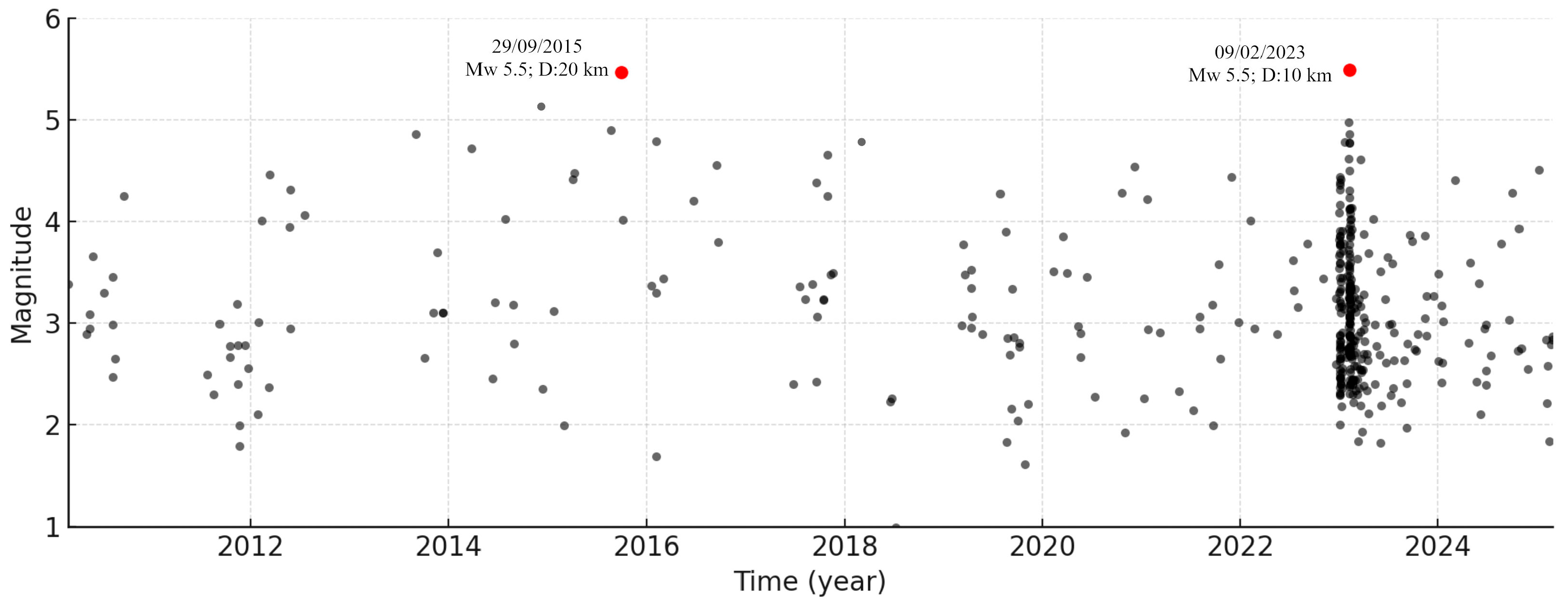
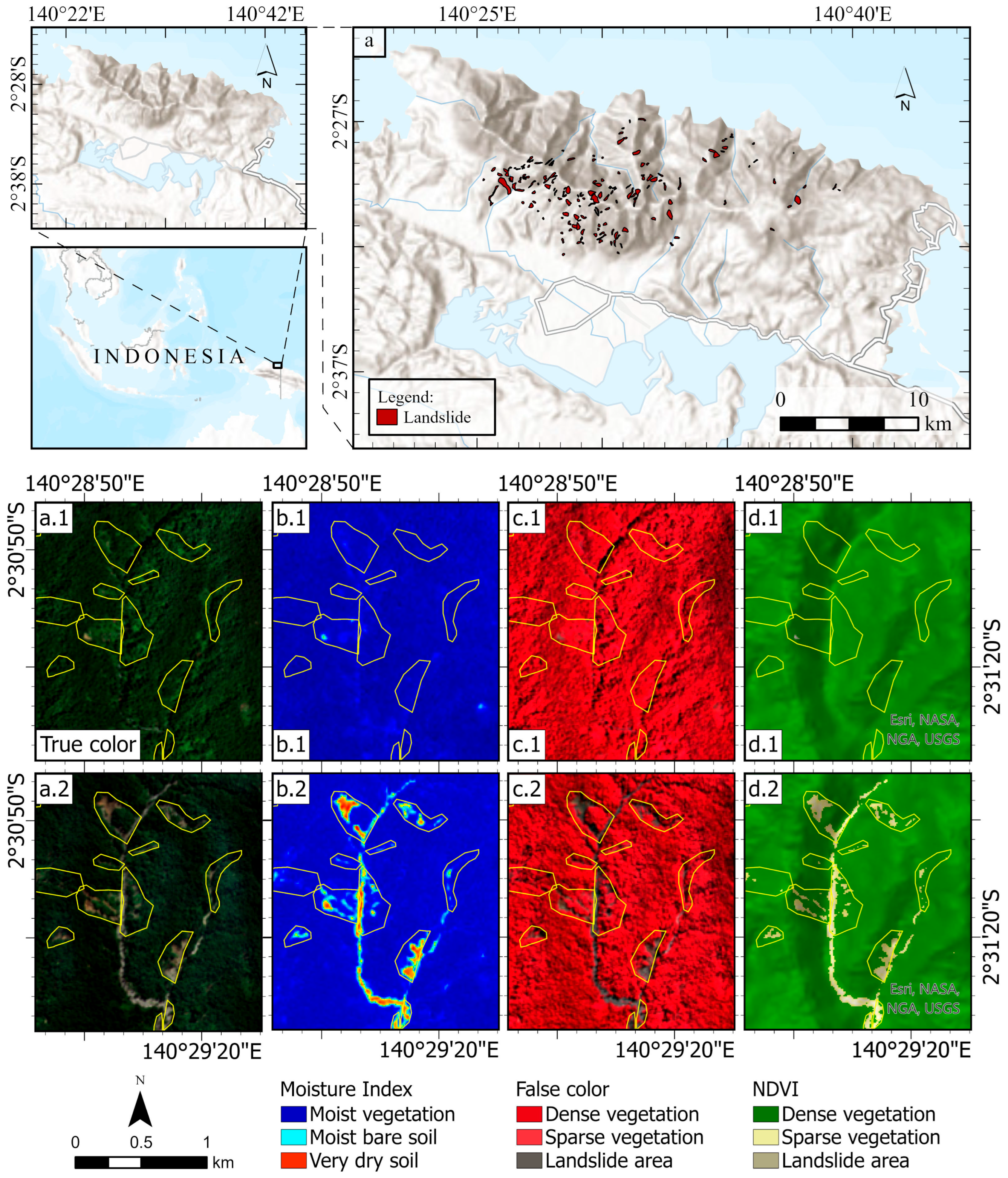
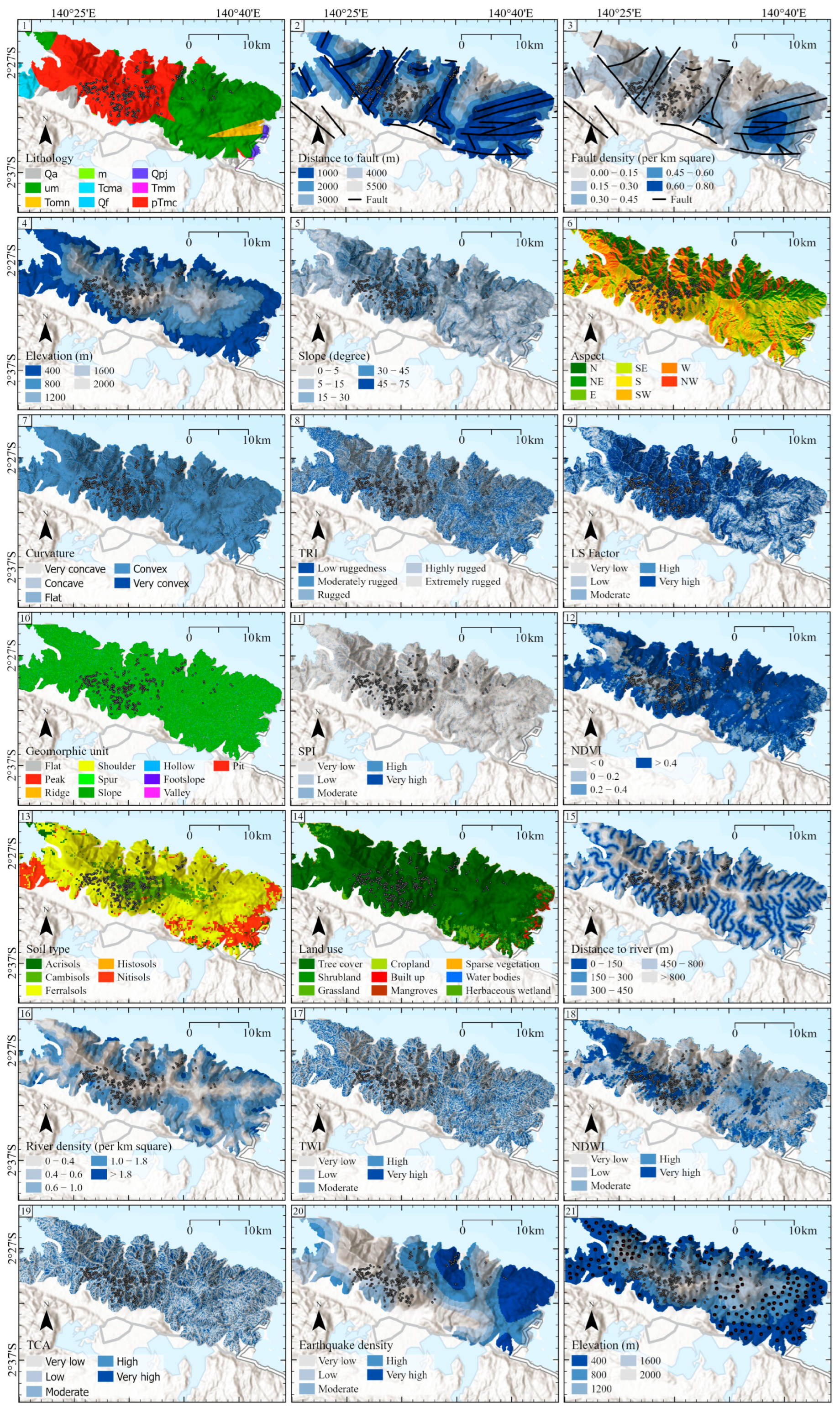
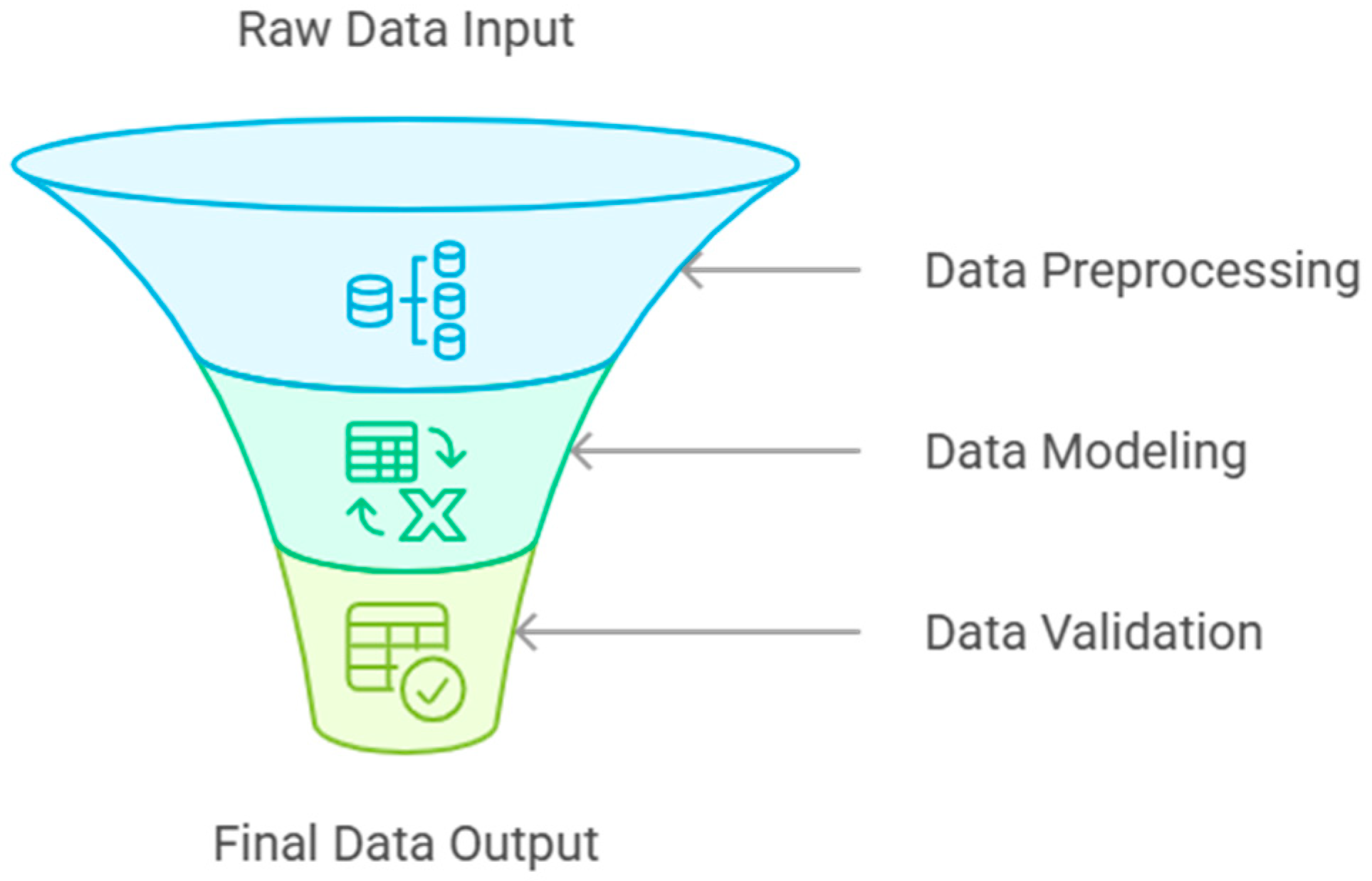


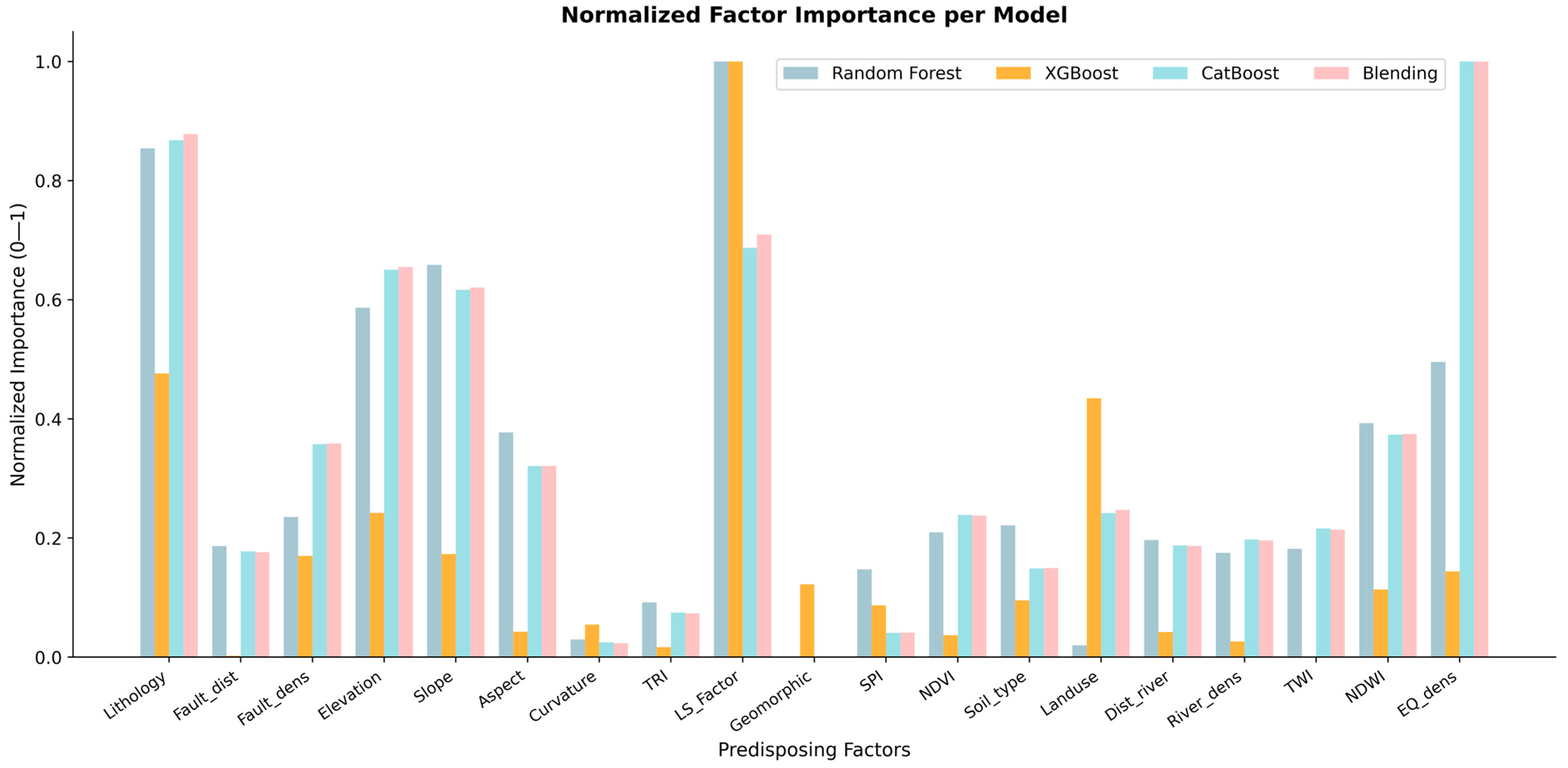
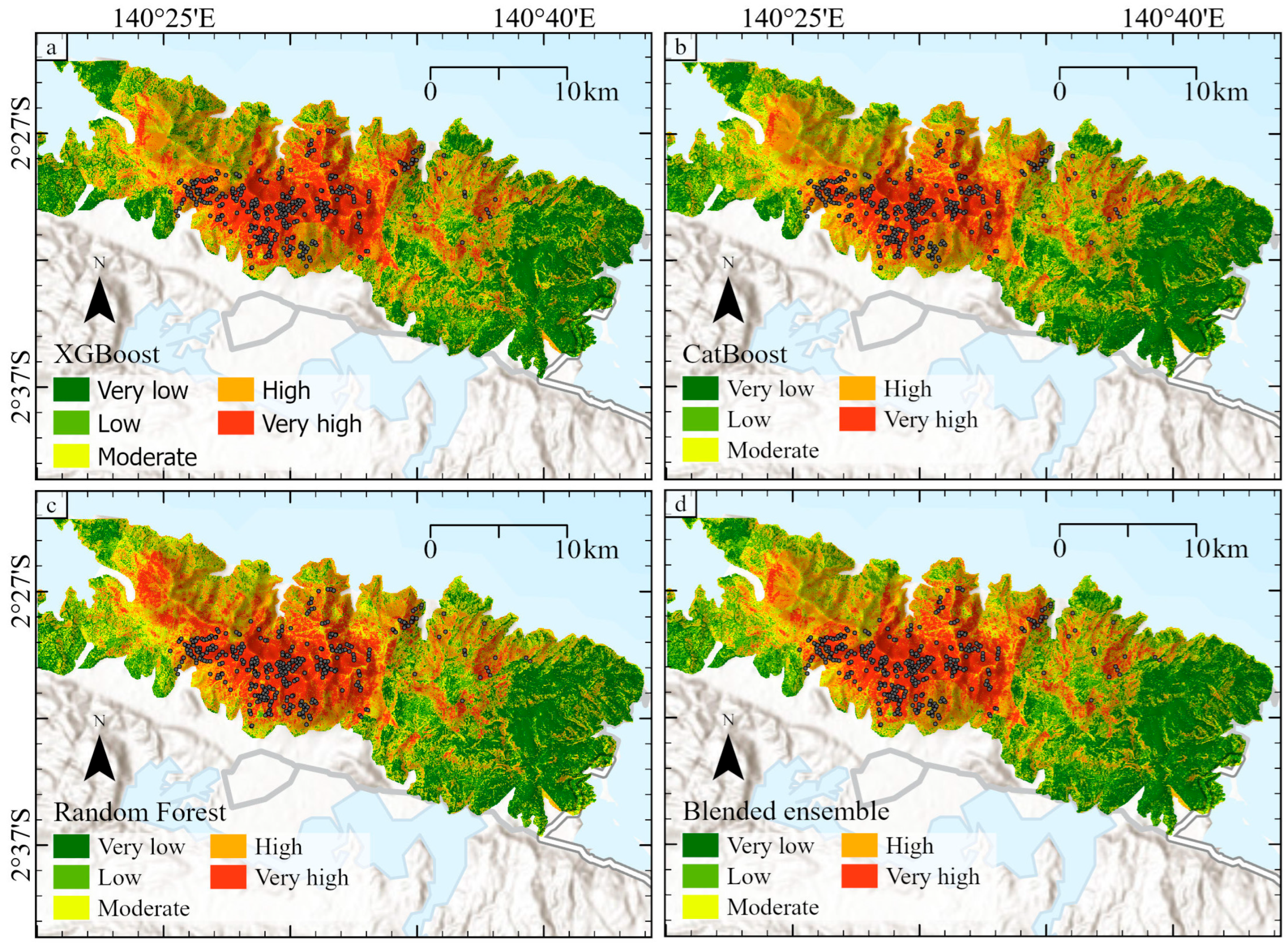


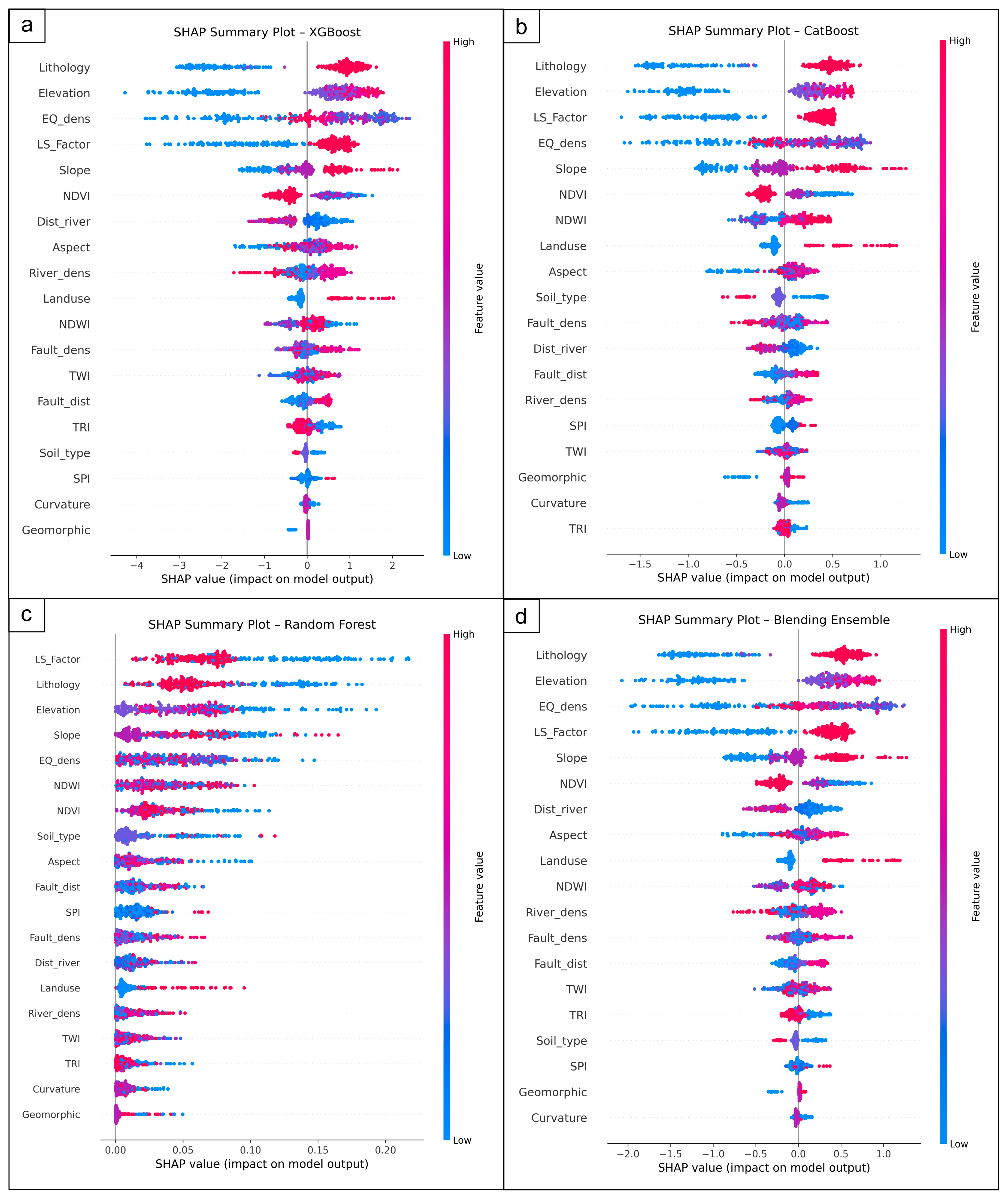
| No | Data Name | Data Source | Spatial Resolution | Data Type | Derivative Maps |
|---|---|---|---|---|---|
| 1 | Digital Elevation Model (DEM) | Ina-Geoportal, Geospatial Information Agency of Indonesia [29] | 8.3 m × 8.3 m | Raster grid | Elevation, Slope, Aspect, Curvature, Terrain Ruggedness Index (TRI), Slope Length Factor (LS Factor); Geomorphic units, Stream Power Index (SPI); Distance to river, River density, Topographic Wetness Index (TWI), Total Catchment Area (TCA) |
| 2 | Geological Map | Geological Map of the Jayapura (Cyclops Mountains) Quadrangle, Irian Jaya, Scale 1:100,000 [26] | 1:100,000 scale | Document | Lithology, Distance to fault, Fault density |
| 3 | Sentinel-2A Satellite Imagery | Copernicus Open Access Hub [21] | 10 m × 10 m | Raster grid | Normalized Difference Vegetation Index (NDVI); Normalized Difference Water Index (NDWI) |
| 4 | Soil Map | SoilGrids by ISRIC—World Soil Information [30] | 250 m × 250 m | Raster grid | Soil type |
| 5 | Land Use Map | ESA WorldCover 2021 V200, European Space Agency [31] | 10 m × 10 m | Raster grid | Land use |
| 6 | Earthquake Catalog | Incorporated Research Institutions for Seismology (IRIS) [27] and BMKG [28] | Point-based; no fixed resolution | Vector shapefile (point) | Earthquake event density |
| Factors | VIF | TOL | Factors | VIF | TOL |
|---|---|---|---|---|---|
| Lithology | 2.13 | 0.47 | SPI | 1.06 | 0.95 |
| Distance to fault | 2.12 | 0.47 | NDVI | 3.03 | 0.33 |
| Fault density | 2.13 | 0.47 | Soil type | 1.58 | 0.63 |
| Elevation | 2.14 | 0.47 | Landuse | 1.16 | 0.86 |
| Slope | 2.51 | 0.40 | Distance to the river | 1.62 | 0.62 |
| Aspect | 1.15 | 0.87 | River density | 1.92 | 0.52 |
| Curvature | 1.32 | 0.76 | TWI | 7.08 | 0.14 |
| TRI | 1.21 | 0.83 | NDWI | 3.08 | 0.32 |
| LS Factor | 2.55 | 0.39 | TCA | 7.36 | 0.14 |
| Geomorphic units | 1.26 | 0.79 | Earthquake density | 1.62 | 0.62 |
| Model | AUC | Accuracy | Precision | Recall | F1-Score |
|---|---|---|---|---|---|
| Random Forest | 0.956 | 0.887 | 0.886 | 0.886 | 0.886 |
| XGBoost | 0.961 | 0.887 | 0.886 | 0.886 | 0.886 |
| CatBoost | 0.963 | 0.887 | 0.886 | 0.886 | 0.886 |
| Blending Ensemble | 0.964 | 0.901 | 0.889 | 0.914 | 0.901 |
Disclaimer/Publisher’s Note: The statements, opinions and data contained in all publications are solely those of the individual author(s) and contributor(s) and not of MDPI and/or the editor(s). MDPI and/or the editor(s) disclaim responsibility for any injury to people or property resulting from any ideas, methods, instructions or products referred to in the content. |
© 2025 by the authors. Licensee MDPI, Basel, Switzerland. This article is an open access article distributed under the terms and conditions of the Creative Commons Attribution (CC BY) license (https://creativecommons.org/licenses/by/4.0/).
Share and Cite
Zulfahmi, Z.; Putra, M.H.Z.; Sarah, D.; Tohari, A.; Madiutomo, N.; Hartanto, P.; Damayanti, R. GIS-Based Landslide Susceptibility Mapping with a Blended Ensemble Model and Key Influencing Factors in Sentani, Papua, Indonesia. Geosciences 2025, 15, 390. https://doi.org/10.3390/geosciences15100390
Zulfahmi Z, Putra MHZ, Sarah D, Tohari A, Madiutomo N, Hartanto P, Damayanti R. GIS-Based Landslide Susceptibility Mapping with a Blended Ensemble Model and Key Influencing Factors in Sentani, Papua, Indonesia. Geosciences. 2025; 15(10):390. https://doi.org/10.3390/geosciences15100390
Chicago/Turabian StyleZulfahmi, Zulfahmi, Moch Hilmi Zaenal Putra, Dwi Sarah, Adrin Tohari, Nendaryono Madiutomo, Priyo Hartanto, and Retno Damayanti. 2025. "GIS-Based Landslide Susceptibility Mapping with a Blended Ensemble Model and Key Influencing Factors in Sentani, Papua, Indonesia" Geosciences 15, no. 10: 390. https://doi.org/10.3390/geosciences15100390
APA StyleZulfahmi, Z., Putra, M. H. Z., Sarah, D., Tohari, A., Madiutomo, N., Hartanto, P., & Damayanti, R. (2025). GIS-Based Landslide Susceptibility Mapping with a Blended Ensemble Model and Key Influencing Factors in Sentani, Papua, Indonesia. Geosciences, 15(10), 390. https://doi.org/10.3390/geosciences15100390







